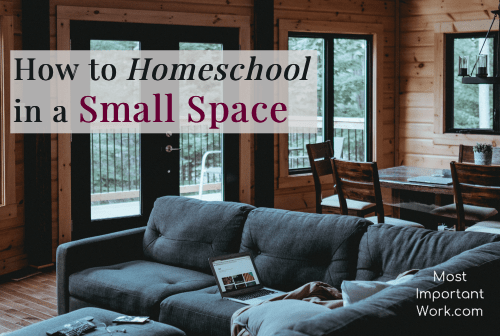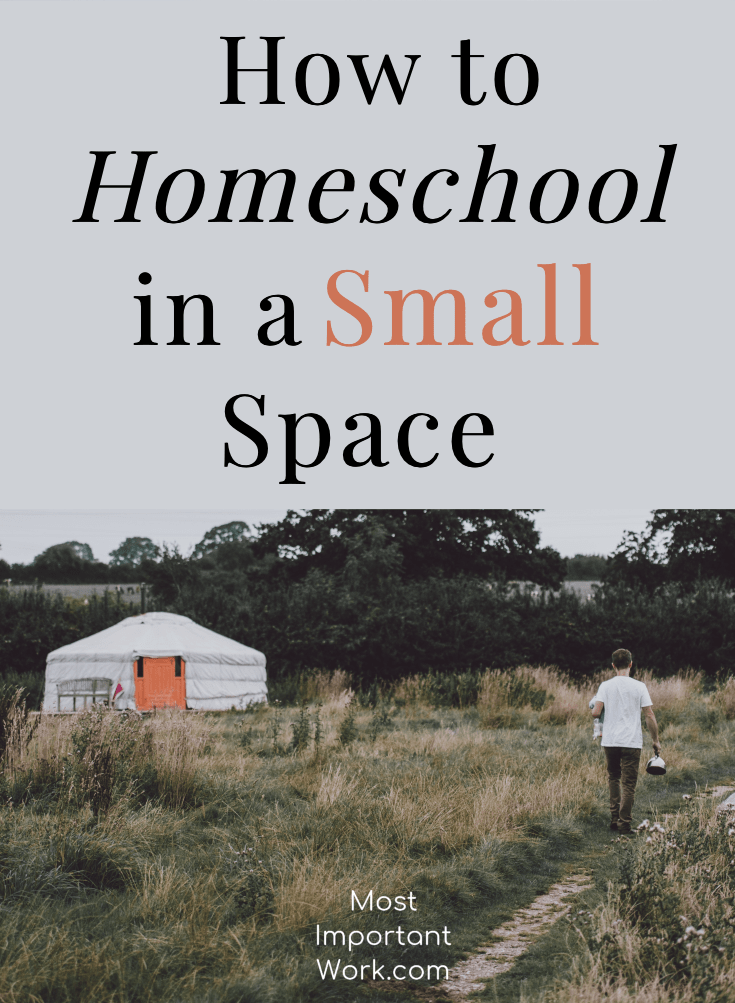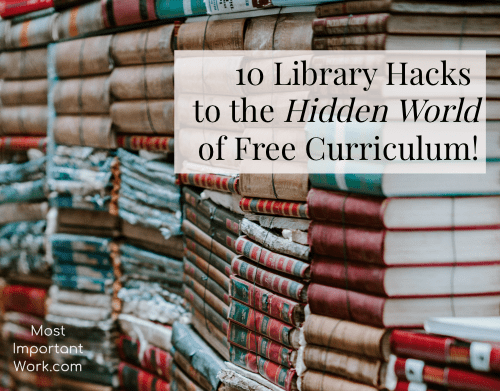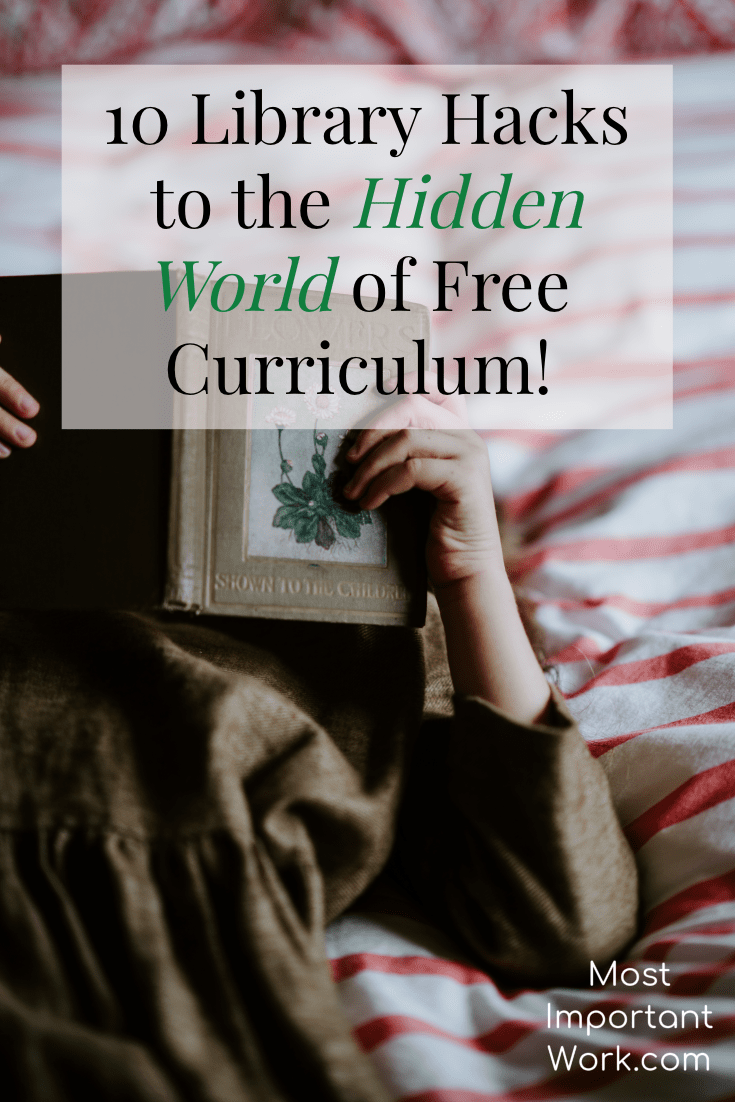
How to Homeschool in a Small Space
Reading Time: 4 min 58 sec
Have you ever wondered if it’s possible to homeschool in a small space? I don’t know about you but sometimes while homeschooling our homes can eerily resemble an episode from Hoarders. Cramped living spaces filled with old curriculum, books, paperwork, supplies, and projects seem to spread like a virus to every nook and cranny.
You sit down to homeschool your child, only to feel frustrated with your inability (and your child’s) to focus due to so many distractions. You organize all of your supplies only to find after a couple of weeks that the clutter has returned.
Your home is supposed to be a retreat but all you see is an endless to-list and an organizing nightmare. You feel overwhelmed, discouraged, and hopeless. You wonder if it is possible to homeschool in a small space without clutter spilling out of every drawer and cabinet!
Every homeschooling parent dreams of perfectly organized spaces where you have plenty of room to spread out and everything you need is always right at your fingertips. I am here to tell you that it doesn’t matter if you have a small or large space. It’s about the practical steps you take to control the clutter.
We are going to be talking about eight practical steps you can take to create a stress-free learning environment:
-
Stop Saving for a Rainy Day
2. Go Digital
3. Something Borrowed
4. In Plain View
5. Establish a Daily Habit
6. Avoid Sales
7. Utilize Media
8. Only Amazing Resources

1. Stop Saving for a Rainy Day
Do you ever keep resources just in case? You bought a math book, tried one or two lessons, you weren’t thrilled, so you put it back on the shelf, in the hope that it might miraculously be a good fit later down the road.
“If you’re not using the stuff in your home, get rid of it. You’re not going to start using it more by shoving it in a closet somewhere.” Joshua Becker
Let me be honest, if you haven’t used it in the last six months most likely you will never use it. Take a good look at all of your curriculum, whether its books, textbooks, handouts, projects and remove everything you haven’t used in six months. * You might be surprised at how many just in case, books and resources take up precious space on your shelves.
Good intentions do not create an organized stress-free home.
*This does not include staples (such as reading or math books) that you will use to teach your next child.
2. Go Digital
Do you have folders crammed full of handwriting samples, artistic masterpieces, math tests, and brochures from every field trip you have visited in the last six months?
I stumbled on this hack out of necessity when my second (of two) homeschool drawer was crammed to overwhelming with past paperwork. My good intentions of putting my paperwork into sheet protectors never ever happened (can anyone relate?).
Maximize your limited space by utilizing a scanning app to save every document (no drawer required). I have loved the flexibility and the price tag (its FREE) of the Genius Scan App. I scan every document and then upload them directly to the computer. It makes creating a portfolio a breeze (almost) every year. Say Hello to Empty Drawers!
If you find a better app, please let me know!
3. Something Borrowed
One of the ways we can run out of space so quickly is storing that reading or math book for two years until your next kid is ready for it. Did you know that the library is a gold mine of FREE Resources that… wait for it… YOU DON’T HAVE TO STORE!
I am talking about more than the lone textbook you found on your last library search, but a vast amount of material that will save you hundreds if not thousands of dollars. Check out this post 10 Library Hacks to the Hidden World of Free Curriculumfor step by step instructions.

4. In Plain View
An important aspect of homeschooling in a small space is being able to see everything at a glance. When organizing DO NOT stuff drawers or place items behind each other hoping to maximize space.
Take time and evaluate your materials. Here is a good rule of thumb when evaluating your materials
- Keep the Best (Is it portfolio worthy?)
- Remove Duplicates (Do you really need 8 pairs of scissors?)
- Get Rid of all of those Scraps of Paper and Trash
- Keep Only what you Love and use Regularly
- Store the Same things Together (ex. Keep all pencils or library books in one spot)
5. Establish a Daily Habit
It is imperative when homeschooling in a small space to establish a daily practice of purging and placing everything back where it belongs. It might seem like an obvious suggestion until it comes to putting it into practice.
We choose to declutter at the end of every afternoon. I set a timer for ten minutes and we run about the house putting projects, books, and supplies away in preparation for dinner. Find a rhythm that works for you whether its right after school, late afternoon or during the evening, the point is to do it every day.
6. Avoid Sales
I don’t know about you but I can get a little carried away at those curriculum and library sales and start treating it like I am in the snack aisle of my local grocery store. I come out cash poor, regretful, and wondering where I am going to put all this stuff.
“It’s not a good deal if you don’t need it” -Unknown
Impulse buying can keep our homes, finances, and mental spaces in a place of chaos and clutter. Avoiding window shopping will go a long way in keeping your home free of mess.
7. Utilize Media
Get rid of some of those big heavy textbooks and utilize your digital resources. Not only can you purchase amazing apps and programs but I was shocked to find Rosetta stone language programs, math tutoring, and streaming documentaries (and that was just the tip of the iceberg) for FREE on my local library’s website. You can check out this article for step by step instructions.
8. Only Amazing Resources
Think of yourself as a curator of the best homeschooling resources. Only allow learning tools that you truly LOVE to enter your home.
“Your home is a living space, not a storage space.” Francine Jay
You do this by borrowing, researching, and committing to return items that do not fit your family’s needs. This step takes intentionality and commitment as there is always the pressure to find that perfect resource FAST. This step will play a huge role in allowing you to homeschool in a small space with peace.
So how do you find those AMAZING resources? Grab your free 10 Tips to Finding Excellent Curriculum checklist (get it below) to help YOU on your homeschooling journey!
What about you? What is your #1 concern when it comes to figuring out this homeschooling adventure?
Please feel free to leave me a comment and don’t forget to follow Most Important Work on Pinterest!












